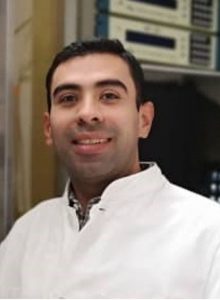
Contact
Triad Technology Center333 Cassell Drive
Room 4500
Baltimore, MD 21224
Education
Ph.D. - Department of Drug Design and Pharmacology - Faculty Medicine and Health Sciences- University of Copenhagen – Denmark (2021)
Predoctoral Fellow. Integrative Neurobiology Section. NIDA/NIH (2019)
Postgraduate Research Training. Neuroscience Research Group (NEUROS), School of Medicine and Health Science. Universidad del Rosario, Bogotá – Colombia (2016)
M.D. - Health Science Faculty - Universidad Tecnológica de Pereira – Colombia (2015)
Research Interests
Dr. Romero-Leguizamon is a medical doctor from Colombia, with experience in basic and clinical research. He performed his doctoral studies at Kohlmeier Lab in the University of Copenhagen (Denmark). In his Ph.D. thesis he has explore the potential role of hypercholinergic state in the relationship between stress and addiction through cell electrophysiology (patch clamp) experiments and indirect changes in the levels of intracellular calcium of the neurons studied in the Laterodorsal Tegmental nucleus (LDT). In addition, he has had the opportunity to study the role of some heteromers within this process using in-vivo microdialysis and optogenetics in the brainstem-sourced cholinergic terminals within VTA. In addition, he has developed some laboratory devices for application and optimization during the performance of his research projects.
Additionally, as an artist (actor and theater director) I have worked on the use of art in medical sciences, as in the Humor Therapy (Doctor Clown) and in the use of art as therapy in addicted patients. Finally, he is an amateur mountain bike rider who enjoys riding his bike every day to work.
Selected Publications
2021
In: J Parkinsons Dis, vol. 11, no. 4, pp. 1773–1790, 2021, ISSN: 1877-718X.
2020
Stress-related endogenous neuropeptides induce neuronal excitation in the Laterodorsal Tegmentum Journal Article
In: Eur Neuropsychopharmacol, vol. 38, pp. 86–97, 2020, ISSN: 1873-7862.
2019
Increasing cellular lifespan with a flow system in organotypic culture of the Laterodorsal Tegmentum (LDT) Journal Article
In: Sci Rep, vol. 9, no. 1, pp. 1486, 2019, ISSN: 2045-2322.
2018
The relationship between the components of idiopathic focal epilepsy Journal Article
In: izamon CRR. The relationship between the components of idiopathic focal epilepsy. , vol. 8, no. 3, pp. 113-119, 2018.
Morphine in Plasma and Cerebrospinal Fluid of Patients Addicted to Opiates Undergoing Surgery: High-performance Liquid Chromatography Method Journal Article
In: Addict Health, vol. 10, no. 2, pp. 95–101, 2018, ISSN: 2008-4633.
Medicine: art or science? A reflection on the arts in medical education Journal Article
In: Educación Médica, vol. 19, no. 6, pp. 359 - 368, 2018, ISSN: 1575-1813.
